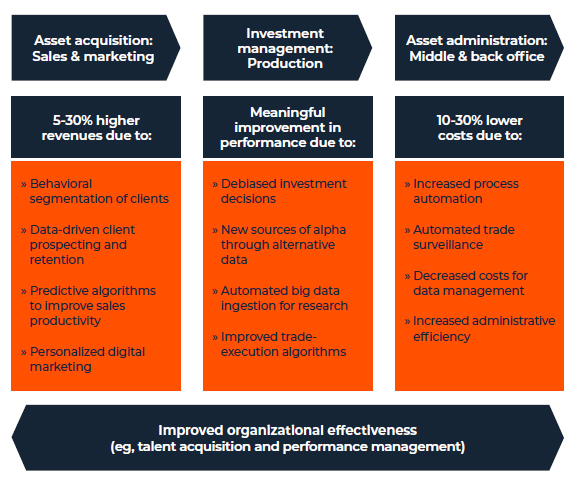
In the age of ‘Open Data’ and evolving customer landscape – asset management leaders will need to separate facts from fiction.
Up till now, asset managers had access to data, but making an insightful decision using the data available wasn’t feasible without a technology enabler. This is influenced all the more considering the volume and variety of data that is available today. Hence, today analytics have become an integral part of the journey of asset management firms across the value chain from front to mid all the way to back office.
According to Accenture’s research of asset management firms:
This journey of analytics can be in the form of different use cases which are detailed below (see figure 1).
USE CASES
Distribution
Asset managers are generally using advanced analytics to optimise distribution processes.
Several asset managers are amassing enormous data repositories of multidimensional client attributes in order to develop distribution, and service models that better enable them to reach the appropriate customers through the right channels at the right time. According to a report by McKinsey, the use of analytics and predictive algorithms can improve actionable insights by up to 80%, especially when it comes to productivity of sales and marketing around the distribution process.
ESG
ESG is a good example because it has many facets and is not easily measurable. In November 2021, the ECB found that fewer than 20% of its regulated banks had developed key risk indicators. At the same time many financial institutions are creating strategies and goals to hit a minimum of 50% of new green lending by the end of the decade.
They also have advanced analytics to bring together disparate sources of data, classify them and come up with some meaningful output as references to risk management that are clearly going to be required. For example, while a carbon footprint might be easy to measure and benchmark, something like ethical behavior or anything contextual is far less straightforward, and subject to nuance and opinion. Looking through large amounts of unstructured data to come to an opinion previously would have been done manually – this is bound by human interference and is also slow and thus inefficient as well as ineffective.
The McKinsey report found however, that “asset managers that have implemented techniques have seen a 55 to 85 percent reduction in time spent on trade surveillance activities and, more importantly, improved risk identification. In one case, an asset manager found that its machine-learning algorithm was significantly better at detecting risks than a seasoned expert reviewing the same underlying materials.”
Figure 1: Asset management firms are applying advanced analytics across the full lifecycle. Source: McKinsey.

Real Estate
Real estate is another example. Being able to accurately predict which investments are likely to prosper using a variety of locationspecific data from a variety of sources is helping to accurately predict factors that contribute to success, such as rent and vacancies. According to McKinsey: “At one leading real estate investment manager, the combination of Yelp reviews, information on traffic flows, and credit card spending data with traditional property and market-level characteristics improved the predictive accuracy of three-year forward rent forecasts from 60 to 70% to over 95%.”
In both examples, the use of AI, machine learning, and natural language processing (NLP) make light work of volumes of data by automating the input process, and then making sense of it by identifying patterns. The technology finds the needle in the haystack that will help to make a better decision.
The Middle Office
Advanced analytics are also useful in the middle office and can be used to automate to provide efficiency and productivity gains as well as accuracy. This is important given the growing number of complex products, all with their own processes and third parties to deal with. Using technology to automate and to make decisions around what to do next, and when to refer something to a human is the idea.
Technology can also improve risk management and compliance again, by monitoring vast amounts of data and routing it where it needs to go, as well as flagging when something is not quite right or breaches a set framework or risk tolerance. Again, the purpose is to save time and provide a high level of accuracy, thus mitigating the risk of human error in functions where getting it right and fixing things quickly if something goes wrong is of paramount importance.
Operations
As well as using tech to improve the offering, asset managers can use it to improve how the firm operates and make decisions based on better analytics, thus informing strategic decision making. RPA using AI to route data and processes is one obvious example of this. The RPA essentially acts as a highly effective, highly accurate PA that does exactly what it has been told to do at lightning-fast speed. This is useful in the middle office context but also in the context of operations, onboarding new employees or in a payroll function for example.
It also has a role to play in an industry where mergers and acquisitions are commonplace and where systems, processes, and data from two previously distinct entities need to come together to make a new whole. Essentially, the tech is being used as an efficiency and accuracy play, and hyper charging automation for operational gain, be that human or financial.
The Right Partnership
But to be able to make full use of the available technology, asset managers need firstly the right knowledge, and then the knowhow to apply it to their company. This is an issue given that the asset management industry is beset by legacy systems that keep data in silos and find it hard to talk to each other. Having the right tech stack is thus key. One way of getting that is via a third party, whose core activity lies in the tech, rather than in managing money, as is the case with asset managers.
Collaboration between financial services providers and specialist third parties is now commonplace and provides many advantages.

The Middle East’s food and beverage (F&B) manufacturing sector is in the midst of a major transformation. As the industry faces rapidly evolving consumer demands, environmental challenges, and the pressure to maintain efficient supply chains, businesses are seeking smarter, more agile solutions.

In today’s fast-paced world, insurance companies are under increasing pressure to deliver quick, efficient, and accurate claims processing

A study by the International Monetary Fund (IMF) estimated that Africa loses an estimated $88.6 billion annually to illicit financial flows, including money laundering. These staggering figures underscore the urgent need for more robust and innovative solutions to tackle this pressing challenge.”
“Artificial Intelligence offers a transformative approach to addressing the complex and evolving challenge of money laundering in Nigeria and Africa.”
We are happy to hear from you and answer your questions. Let's begin our journey together.